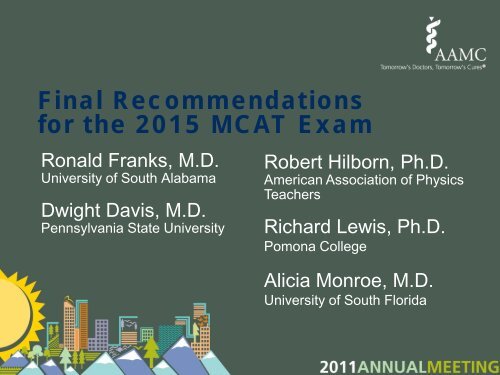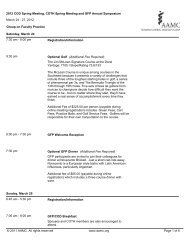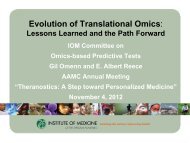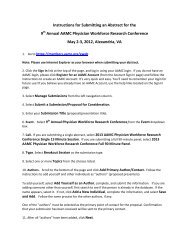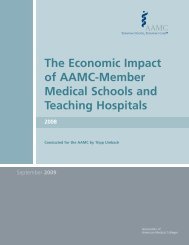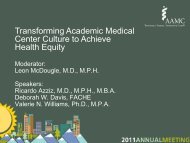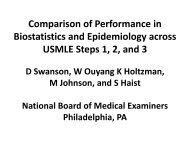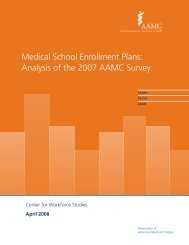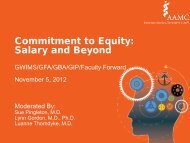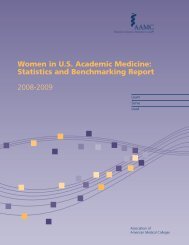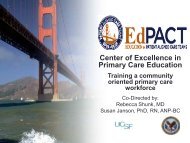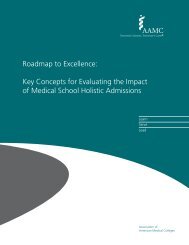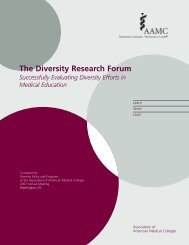Final Recommendations for the 2015 MCAT Exam - AAMC's ...
Final Recommendations for the 2015 MCAT Exam - AAMC's ...
Final Recommendations for the 2015 MCAT Exam - AAMC's ...
Create successful ePaper yourself
Turn your PDF publications into a flip-book with our unique Google optimized e-Paper software.
<strong>Final</strong> <strong>Recommendations</strong><br />
<strong>for</strong> <strong>the</strong> <strong>2015</strong> <strong>MCAT</strong> <strong>Exam</strong><br />
Ronald Franks, M.D.<br />
University of South Alabama<br />
Dwight Davis, M.D.<br />
Pennsylvania State University<br />
Robert Hilborn, Ph.D.<br />
American Association of Physics<br />
Teachers<br />
Richard Lewis, Ph.D.<br />
Pomona College<br />
Alicia Monroe, M.D.<br />
University of South Florida
Why did we review <strong>the</strong> <strong>MCAT</strong> exam?<br />
• A 21-member advisory committee reviewed <strong>the</strong><br />
<strong>MCAT</strong> exam to determine if it provides admissions<br />
committees with valuable in<strong>for</strong>mation about <strong>the</strong>ir<br />
applicants’ academic readiness and reflects <strong>the</strong>ir<br />
schools’ goals <strong>for</strong> tomorrow’s physicians.<br />
• In standardized testing, periodic reviews of<br />
examinations are considered a best practice and<br />
are particularly important in fields with rapidlychanging<br />
knowledge.<br />
2
Why did we review <strong>the</strong> <strong>MCAT</strong> exam?<br />
• This is <strong>the</strong> fifth time <strong>MCAT</strong> was reviewed since its<br />
first administration in 1928.<br />
• The current exam has been in use since 1991.<br />
• The new version of <strong>the</strong> test is likely to be in place<br />
through 2030—with a plan to refresh it midway<br />
through so <strong>the</strong> exam keeps pace with changing<br />
science.<br />
3
What did we accomplish?<br />
• Began our work on <strong>the</strong> future test in fall 2008<br />
• Did a lot of fact finding<br />
• Solicited input from several blue-ribbon and<br />
advisory committees, including:<br />
• Scientific Foundations <strong>for</strong> Future Physicians<br />
Committee<br />
• Behavioral and Social Sciences Foundations <strong>for</strong><br />
Future Physicians Committee<br />
• Holistic Review Project Advisory Committee<br />
4
What did we accomplish?<br />
• Received over 2700 completed surveys from<br />
baccalaureate and medical school faculty and<br />
administrators, residents, and medical students<br />
• Solicited input on <strong>the</strong> future exam at over 90<br />
outreach events<br />
• Published project brochures, newsletters, and data<br />
reports<br />
• Posted <strong>the</strong>se and videos on <strong>the</strong> MR5 website<br />
• Sent regular e-newsletters to over 4000<br />
stakeholders<br />
5
What did we accomplish?<br />
• Presented <strong>the</strong> preliminary recommendations to<br />
AAMC’s Board of Directors last February and <strong>the</strong><br />
recommendations were favorably received<br />
• Released <strong>the</strong>m to <strong>the</strong> AAMC and pre-health<br />
communities and press in March<br />
• Discussed <strong>the</strong>m in over 20 national, local, and<br />
trade papers and in over 30 student newspapers<br />
• Presented <strong>the</strong>m at <strong>the</strong> spring GSA and NAAHP<br />
meetings and at o<strong>the</strong>r meetings and conferences<br />
this spring and summer<br />
6
What are <strong>the</strong> next steps?<br />
• Previewed <strong>the</strong> final recommendations with<br />
recipients of <strong>the</strong> MR5 e-newsletter last month<br />
• Will talk about <strong>the</strong> recommendations today and<br />
on Tuesday<br />
• Have just a released a Preview Guide <strong>for</strong> <strong>the</strong><br />
new exam, with detailed descriptions of <strong>the</strong><br />
knowledge and skills <strong>the</strong> new exam will test,<br />
along with sample test questions<br />
• AAMC’s leadership will propose <strong>the</strong> future test to<br />
AAMC’s Board of Directors in February<br />
7
MR5 Timeline<br />
MR5<br />
committee<br />
convenes<br />
Committee<br />
deliberates,<br />
hosts 90<br />
outreach events<br />
Innovation lab<br />
investigates personal<br />
competency measures<br />
Preliminary<br />
recommendations<br />
released <strong>for</strong><br />
public comment<br />
<strong>Final</strong><br />
recommendations<br />
released at<br />
annual meeting<br />
<strong>Recommendations</strong><br />
go to AAMC BOD<br />
<strong>for</strong> approval<br />
New exam<br />
goes live<br />
<strong>2015</strong><br />
Fall 2008 Dec. 2009–<br />
Sept. 2010<br />
2008-2011 March 2011<br />
November 2011<br />
Feb. 2012<br />
8
What are our goals <strong>for</strong> <strong>the</strong> <strong>2015</strong><br />
<strong>MCAT</strong>?<br />
• Preserve what works best<br />
• Eliminate what doesn’t – drop <strong>the</strong> Writing<br />
Sample section<br />
• Enrich <strong>the</strong> exam with more biochemistry and <strong>the</strong><br />
scientific foundations of behavior<br />
• Use a testing <strong>for</strong>mat that already has proven to<br />
be successful<br />
• Reliable<br />
• Good predictor of grades in medical school,<br />
time to graduation, USMLE results, and o<strong>the</strong>r<br />
student outcomes<br />
9
What else are we recommending?<br />
• Resources that AAMC should provide to<br />
• examinees,<br />
• pre-health advisors, and<br />
• admissions officers<br />
to help <strong>the</strong>m prepare <strong>for</strong> <strong>the</strong> new exam.<br />
10
What else are we recommending?<br />
• Work that AAMC should do that goes beyond <strong>the</strong><br />
exam to develop new measures of<br />
• integrity,<br />
• service orientation, and<br />
• o<strong>the</strong>r personal characteristics<br />
that admissions committees can use early in<br />
student selection.<br />
11
12<br />
What are our recommendations<br />
about <strong>the</strong> content and <strong>for</strong>mat of <strong>the</strong><br />
new test?
Include 4 test sections and report 4<br />
scores, including <strong>the</strong>:<br />
• Biological and biochemical foundations of living<br />
systems<br />
• Chemical and physical foundations of biological<br />
systems<br />
• Psychological, social, and biological<br />
foundations of behavior<br />
• Critical analysis and reasoning skills<br />
13
Preserve what’s best:<br />
• Natural science tests will be organized around<br />
concepts described by <strong>the</strong> SFFP committee as<br />
important to entering students’ success<br />
• Reflect medical school faculty’s, residents’, and<br />
students’ ratings of <strong>the</strong> most important of <strong>the</strong>se<br />
• Test examinees’ knowledge and use of <strong>the</strong><br />
highly-rated concepts in<br />
• biology<br />
• cellular/molecular biology<br />
• general and organic chemistry<br />
• biochemistry<br />
• physics<br />
• research methods and statistics<br />
14
Preserve what’s best:<br />
• At many schools, students currently learn <strong>the</strong>se<br />
concepts in introductory biology, general and<br />
organic chemistry, and physics, and in firstsemester<br />
biochemistry courses<br />
• Cellular/molecular biology concepts that will be<br />
tested are taught in most introductory biology<br />
sequences<br />
• Research methods and statistics concepts that<br />
will be tested are foundational and described by<br />
undergraduate faculty as important to students’<br />
success in introductory science courses<br />
15
Preserve what’s best:<br />
Questions on <strong>the</strong> two exams will ask examinees to<br />
combine<br />
• knowledge of natural sciences concepts with<br />
• scientific inquiry, reasoning, research methods<br />
and statistics skills to solve problems that<br />
demonstrate readiness <strong>for</strong> medical school<br />
Scientific inquiry, reasoning,<br />
research methods, and<br />
statistics skills<br />
Natural Sciences<br />
Concepts<br />
Questions<br />
16
What are our goals <strong>for</strong> <strong>the</strong> <strong>2015</strong><br />
<strong>MCAT</strong>?<br />
• Preserve what works best,<br />
• Eliminate what doesn’t, and<br />
• Enrich <strong>the</strong> exam by giving attention to concepts<br />
that future physicians are likely to need—using<br />
a testing <strong>for</strong>mat that already has proven to be<br />
successful.<br />
17
What else are we recommending?<br />
• Resources that AAMC should provide to<br />
examinees, pre-health advisors, and admissions<br />
officers to help <strong>the</strong>m prepare <strong>for</strong> <strong>the</strong> new exam<br />
• Work that AAMC should do that goes beyond <strong>the</strong><br />
exam to develop new measures of integrity,<br />
service orientation, and o<strong>the</strong>r personal<br />
characteristics that admissions committees can<br />
use early in student selection<br />
18
19<br />
What are our recommendations<br />
about <strong>the</strong> content and <strong>for</strong>mat of <strong>the</strong><br />
new test?
Include 4 test sections and report 4<br />
scores, including <strong>the</strong>:<br />
• Biological and biochemical foundations of living<br />
systems<br />
• Chemical and physical foundations of biological<br />
systems<br />
• Psychological, social, and biological<br />
foundations of behavior<br />
• Critical analysis and reasoning skills<br />
20
Preserve what’s best:<br />
• Two natural science tests will be organized<br />
around concepts described by <strong>the</strong> SFFP<br />
committee as important to entering students’<br />
success<br />
• Reflect medical school faculty’s, residents’, and<br />
students’ ratings of <strong>the</strong> most important of <strong>the</strong>se<br />
• Will test examinees’ knowledge and use of <strong>the</strong><br />
highly-rated concepts in biology, general and<br />
organic chemistry, physics, biochemistry,<br />
cellular/molecular biology, research methods,<br />
and statistics<br />
21
Preserve what’s best:<br />
• At many schools, students currently learn <strong>the</strong>se<br />
concepts in introductory biology, general and<br />
organic chemistry, and physics, and in firstsemester<br />
biochemistry courses<br />
• Cellular/molecular biology concepts that will be<br />
tested are taught in most introductory biology<br />
sequences<br />
• Research methods and statistics concepts that<br />
will be tested are foundational and described by<br />
undergraduate faculty as important to students’<br />
success in introductory science courses<br />
22
Preserve what’s best:<br />
• Questions on <strong>the</strong> two exams will ask examinees<br />
to combine <strong>the</strong>ir knowledge of natural sciences<br />
concepts with <strong>the</strong>ir scientific inquiry, reasoning,<br />
research methods and statistics skills to solve<br />
problems that demonstrate readiness <strong>for</strong><br />
medical school<br />
Scientific inquiry, reasoning,<br />
research methods, and<br />
statistics skills<br />
Natural Sciences<br />
Concepts<br />
Questions<br />
23
Preserve what’s best:<br />
• Critical analysis and reasoning section will test<br />
examinees’ reasoning by asking <strong>the</strong>m to critically<br />
analyze, evaluate, and apply in<strong>for</strong>mation provided<br />
by passages<br />
• Encourage examinees to read broadly and in<br />
humanities and social sciences disciplines to<br />
familiarize <strong>the</strong>mselves with <strong>the</strong> issues <strong>the</strong>y raise<br />
• Will include passages from ethics and philosophy,<br />
cross-cultural studies, population health, and a wide<br />
range of social sciences and humanities disciplines<br />
• Questions won’t require disciplinary knowledge--all<br />
needed in<strong>for</strong>mation will appear in <strong>the</strong> passages<br />
24
Eliminate what’s not:<br />
• Drop <strong>the</strong> Writing Sample section because:<br />
• Data show that most admissions committees<br />
use WS scores <strong>for</strong> relatively few applicants,<br />
and<br />
• Though WS scores and medical student<br />
outcomes have small positive correlations,<br />
WS has little incremental predictive value<br />
over UGPA and VR scores.<br />
• More about <strong>the</strong> Writing Sample later . . .<br />
25
Enrich <strong>the</strong> exam:<br />
• Psychological, social, and biological foundations<br />
of behavior section will test knowledge and use<br />
of concepts that provide a solid foundation <strong>for</strong><br />
learning in medical school about <strong>the</strong> behavioral<br />
and socio-cultural determinants of health and<br />
health outcomes<br />
• Organized around concepts described by <strong>the</strong><br />
Behavioral and Social Sciences Foundations <strong>for</strong><br />
Future Physicians Committee as important to<br />
medical students’ success<br />
26
Enrich <strong>the</strong> exam:<br />
The new section will test:<br />
• Ways in which psychological, social, and<br />
biological factors influence our perceptions and<br />
reactions to <strong>the</strong> world<br />
• Behavior and behavior change<br />
• What we think about ourselves and o<strong>the</strong>rs<br />
• Cultural and social differences that influence<br />
well-being<br />
• Relationships between social stratification,<br />
access to resources, and well-being<br />
27
Enrich <strong>the</strong> exam:<br />
• At many schools, students currently learn <strong>the</strong>se<br />
concepts in first-semester psychology and<br />
sociology (and in introductory biology)<br />
• Questions will ask examinees to combine <strong>the</strong>ir<br />
knowledge of <strong>the</strong>se concepts with <strong>the</strong>ir scientific<br />
inquiry, reasoning, research methods and<br />
statistics skills to solve problems that<br />
demonstrate readiness <strong>for</strong> medical school<br />
Social and Behavioral<br />
Sciences Concepts<br />
Scientific inquiry, reasoning,<br />
research methods, and<br />
statistics skills<br />
Questions<br />
28
Again, includes 4 test sections and<br />
reports 4 scores:<br />
• Biological and biochemical foundations of living<br />
systems<br />
• Chemical and physical foundations of biological<br />
systems<br />
• Psychological, social, and biological<br />
foundations of behavior<br />
• Critical analysis and reasoning skills<br />
29
Includes 4 test sections and reports<br />
4 scores:<br />
• Section scores will have greater accuracy and be<br />
more interpretable than current section scores<br />
• Sections will include more test questions and be<br />
longer than <strong>the</strong> current sections<br />
• This will leng<strong>the</strong>n <strong>the</strong> testing day from about <strong>the</strong><br />
current 5½ hours to about 7½ hours (with time<br />
<strong>for</strong> administrative issues, breaks, and lunch)<br />
30
Includes 4 test sections and reports<br />
4 scores:<br />
• New biochemistry, psychology, and sociology<br />
content will call <strong>for</strong> additional study<br />
• At many schools, students currently learn <strong>the</strong>se<br />
concepts in first-semester biochemistry,<br />
psychology, and sociology courses<br />
• Without in<strong>for</strong>mation about <strong>the</strong> new test, a<br />
quarter of current applicants take all three of<br />
<strong>the</strong>se courses, 40% take two, 30% take one,<br />
and 5% take none<br />
31
Additionally, we recommend:<br />
• Introduce <strong>the</strong> new exam in <strong>2015</strong><br />
• Report scores on a scale that’s similar to <strong>the</strong><br />
current 1-15 scale, ra<strong>the</strong>r than on a pass/ fail or<br />
o<strong>the</strong>r categorical scale<br />
• Report scores with confidence bands around<br />
<strong>the</strong>m so users are reminded of <strong>the</strong> error<br />
associated with applicants’ scores<br />
• Update <strong>the</strong> content that <strong>the</strong> exam tests on a<br />
regular schedule to ensure that <strong>MCAT</strong> keeps<br />
pace with <strong>the</strong> rapid changes in science<br />
32
33<br />
What are our recommendations<br />
about <strong>the</strong> resources AAMC should<br />
provide to examinees, pre-health<br />
faculty, and admissions committees<br />
<strong>for</strong> <strong>the</strong> new exam?
Resources <strong>for</strong> admission officers:<br />
• Webinars, guides and o<strong>the</strong>r resources that<br />
clearly describe <strong>the</strong> new exam and <strong>the</strong> types of<br />
decisions test scores are and are not designed<br />
to support in a holistic review of applicants’<br />
qualifications<br />
• A new Validity Studies Service to help medical<br />
schools track data and conduct research on <strong>the</strong><br />
value and validity of <strong>the</strong> new exam <strong>for</strong> student<br />
selection at <strong>the</strong>ir schools<br />
34
Resources <strong>for</strong> prospective<br />
examinees:<br />
• Preview Guide <strong>for</strong> <strong>MCAT</strong> <strong>2015</strong><br />
• detailed descriptions <strong>for</strong> all 4 sections,<br />
including knowledge and skills tested<br />
• detailed topic lists<br />
• sample test questions<br />
• www.aamc.org/mcat<strong>2015</strong>/preview.pdf<br />
• Videos describing <strong>MCAT</strong> <strong>2015</strong> and preparation<br />
• Dedicated web site: www.aamc.org/mcat<strong>2015</strong><br />
• The Official Guide to <strong>MCAT</strong> <strong>2015</strong> by 2014<br />
• Free full-length practice test online by 2014<br />
35
Financial support <strong>for</strong> examinees:<br />
• Low-cost and free preparation materials<br />
• Fee Assistance Program includes <strong>MCAT</strong>:<br />
• Reduced fee <strong>for</strong> <strong>MCAT</strong><br />
• Free copy of The Official Guide to <strong>MCAT</strong> <strong>2015</strong><br />
• <strong>Exam</strong>inees with special needs have access to<br />
$500 scholarships <strong>for</strong> <strong>the</strong> costs of evaluations<br />
that <strong>the</strong>y need to apply <strong>for</strong> testing<br />
accommodations<br />
36
Reaching ALL students:<br />
• Special attention to <strong>the</strong> educational needs of<br />
students at under-resourced institutions:<br />
• Student organizations and fairs<br />
• ‘Boots-on-<strong>the</strong>-ground’ support from medical<br />
students, admissions staff, and diversity<br />
officers<br />
• Support to <strong>the</strong>ir advisors and faculty<br />
• Continuing work on outreach strategies <strong>for</strong><br />
educationally- and economically-disadvantaged<br />
students<br />
37
Resources <strong>for</strong> advisors and o<strong>the</strong>r<br />
faculty:<br />
• Preview Guide <strong>for</strong> <strong>MCAT</strong> <strong>2015</strong> – detailed<br />
explanations of concepts, topic lists, and sample<br />
questions<br />
• Advisor section of web site:<br />
www.aamc.org/mcat<strong>2015</strong><br />
• Webinars and conference presentations<br />
• Complimentary copies of The Official Guide to<br />
<strong>MCAT</strong> <strong>2015</strong><br />
• Discounts on bulk orders of preparation materials,<br />
including practice tests <strong>for</strong> <strong>MCAT</strong> <strong>2015</strong><br />
38
Resources <strong>for</strong> advisors and o<strong>the</strong>r<br />
faculty:<br />
• PreHealthCollaborative curriculum-sharing<br />
project to encourage innovation<br />
• Online repository of instructional modules <strong>for</strong><br />
concepts that entering medical students need<br />
to know<br />
• Cataloged by concept<br />
• User comments feature to support use<br />
• Makes it easier to adopt innovative content<br />
and methods in existing courses<br />
39
Resources <strong>for</strong> advisors and o<strong>the</strong>r<br />
faculty:<br />
• Special attention to under-resourced institutions<br />
through:<br />
• Direct outreach, especially to advisors and<br />
faculty at minority-serving schools<br />
• Conferences and professional organizations<br />
• ‘Boots-on-<strong>the</strong>-ground’ support from medical<br />
students, admissions staff, and diversity<br />
officers<br />
40
41<br />
What are our recommendations <strong>for</strong><br />
helping medical schools consider<br />
data on integrity, service<br />
orientation, and o<strong>the</strong>r personal<br />
characteristics early in student<br />
selection?
Go beyond <strong>the</strong> <strong>MCAT</strong> exam to:<br />
Investigate options <strong>for</strong> ga<strong>the</strong>ring data about<br />
personal characteristics through:<br />
• A new section of <strong>the</strong> AMCAS application that<br />
asks applicants to reflect on experiences that<br />
demonstrate <strong>the</strong>ir personal characteristics, and<br />
• Standardized letters that ask recommenders to<br />
rate and write about behaviors that demonstrate<br />
applicants’ personal and academic<br />
characteristics.<br />
42
Go beyond <strong>the</strong> <strong>MCAT</strong> exam to:<br />
• Mount a rigorous program of research on <strong>the</strong><br />
extent to which applicants’ personal<br />
characteristics might be measured:<br />
• As part of a separate regional or national<br />
event, or<br />
• Locally by admissions committees using<br />
nationally-developed tools.<br />
• The timeline <strong>for</strong> this work isn’t tied to introduction<br />
of <strong>the</strong> new exam.<br />
• Hear more on Tuesday morning at 8:00 in <strong>the</strong><br />
Convention Center, Room 205/207.<br />
43
What are <strong>the</strong> next implementation<br />
steps?<br />
• Refine blueprints <strong>for</strong> item writing and test<br />
construction<br />
• Conduct small-scale studies of possible group<br />
differences on new content<br />
• Field test new content in 2013 and 2014<br />
• Stop administering <strong>the</strong> Writing Sample in 2013<br />
and use <strong>the</strong> last hour of <strong>the</strong> operational test to<br />
collect field-test data from examinees who<br />
volunteer<br />
44
45<br />
What are <strong>the</strong> reasons <strong>for</strong> our<br />
recommendations?
What are <strong>the</strong> reasons <strong>for</strong> our<br />
recommendations?<br />
• Using a testing <strong>for</strong>mat that has proven<br />
successful, our recommendations preserve what<br />
works, eliminate what isn’t working and, by<br />
attending to concepts that future physicians are<br />
likely to need, fur<strong>the</strong>r enrich <strong>the</strong> exam.<br />
• They balance testing between <strong>the</strong> natural<br />
sciences, <strong>the</strong> social and behavioral sciences,<br />
and critical analysis and reasoning.<br />
• They respond to <strong>the</strong> SFFP and BSSFFP<br />
recommendations and reflect current science.<br />
46
What are <strong>the</strong> reasons <strong>for</strong> our<br />
recommendations?<br />
• They ask examinees to demonstrate <strong>the</strong>ir<br />
knowledge of <strong>the</strong> natural, social, and behavioral<br />
sciences by solving problems that call <strong>for</strong><br />
scientific thinking, research, and statistics skills.<br />
• They communicate <strong>the</strong> need <strong>for</strong> students who<br />
are prepared to deal with <strong>the</strong> human and social<br />
issues of medicine, and <strong>the</strong>y stress <strong>the</strong> necessity<br />
of reading broadly to prepare <strong>for</strong> medical school.<br />
47
Hear more:<br />
AAMC Focus Session<br />
Rethinking Admissions: Gateway to <strong>the</strong><br />
Profession of Medicine<br />
Tuesday 8:00-9:30<br />
Convention Center, Room 205/207<br />
48
49<br />
Questions?
MR5 Committee Members<br />
Steven G. Gabbe, M.D. (Chair)<br />
Sr. Vice President <strong>for</strong> Health Sciences<br />
CEO, The OSU Medical Center<br />
The Ohio State University<br />
College of Medicine<br />
Ronald D. Franks, M.D. (Vice Chair)<br />
VP, Health Sciences<br />
University of South Alabama<br />
Health Sciences Division<br />
Robert Hilborn, Ph.D.<br />
Associate Executive Officer<br />
American Association of Physics Teachers<br />
( <strong>for</strong>merly, University of Texas at Dallas)<br />
Barry A. Hong, Ph.D., M.DIV.<br />
Professor of Psychiatry<br />
and Medicine<br />
Washington University in St. Louis<br />
School of Medicine<br />
Lisa T. Alty, Ph.D.<br />
Professor and Head, Dept. of Chemistry<br />
Washington and Lee University<br />
Dwight Davis, M.D.<br />
Associate Dean <strong>for</strong> Admissions & Student Affairs<br />
Pennsylvania State University<br />
College of Medicine<br />
J. Kevin Dorsey, M.D., Ph.D.<br />
Dean and Provost<br />
SIU School of Medicine<br />
Michael J. Friedlander, Ph.D.<br />
Founding Executive Director<br />
Virginia Tech Carilion Research Institute<br />
Richard Lewis, Ph.D.<br />
Prof. of Psychology and Neuroscience<br />
Pomona College<br />
Maria F. Lima, Ph.D.<br />
Dean, School of Graduate Studies<br />
Meharry Medical College<br />
Ca<strong>the</strong>rine R. Lucey, M.D.<br />
Vice Dean <strong>for</strong> Education<br />
UCSF School of Medicine<br />
Alicia Monroe, M.D.<br />
Vice Dean, Educational Affairs<br />
University of South Florida<br />
College of Medicine<br />
50
MR5 Committee Members<br />
Saundra H. Oyewole, Ph.D.<br />
Professor and Chair of Biology<br />
Trinity Washington University<br />
Richard M. Schwartzstein, M.D.<br />
Professor of Medicine<br />
Beth Israel Deaconess Medical Center<br />
Erin A. Quinn, Ph.D., M.Ed.<br />
Associate Dean of Admissions Emeritus<br />
Co-Director, Primary Care Community Medicine Program<br />
Keck School of Medicine University of Sou<strong>the</strong>rn Cali<strong>for</strong>nia<br />
Richard K. Riegelman, M.D., Ph.D.<br />
Professor of Epidemiology<br />
Biostatistics, Medicine and Health Policy<br />
Founding Dean<br />
The George Washington University<br />
School of Public Health and Health Services<br />
Gary C. Rosenfeld, Ph.D.<br />
Professor, Integrative Biology and<br />
Pharmacology<br />
University of Texas Medical School<br />
at Houston<br />
Wayne M. Samuelson, M.D.<br />
Associate Dean of Admissions<br />
University of Utah School of Medicine<br />
Maureen Shandling, M.D.<br />
Senior Vice President, Medical<br />
Mount Sinai Hospital<br />
Associate Professor, Division of Neurology<br />
Faculty of Medicine, University of Toronto<br />
Ms. Ca<strong>the</strong>rine Spina<br />
Boston University School of Medicine<br />
MD/PhD Candidate<br />
Expected Graduation <strong>2015</strong><br />
Ricci Sylla, M.D.<br />
PGY-1 Ob/Gyn<br />
Kaiser Permanente Santa Clara<br />
James W/ Pellegrino, Ph.D. (Committee Consultant)<br />
Psychology and Education<br />
University of Illinois, Chicago<br />
Paul R. Sackett, Ph. D. (Committee Consultant)<br />
Industrial/Organizational Psychologist<br />
University of Minnesota<br />
51
Innovation Lab Working Group Members<br />
Thomas W. Koenig, M.D.<br />
Associate Dean <strong>for</strong> Student Affairs<br />
Johns Hopkins University<br />
School of Medicine<br />
Joy P. Williams<br />
Associate Dean <strong>for</strong> Students and Special Programs<br />
Georgetown University<br />
School of Medicine<br />
Samuel K. Parrish, M.D.<br />
Senior Associate Dean <strong>for</strong> Student Affairs and Admissions<br />
Drexel University<br />
College of Medicine<br />
MR5 Staff<br />
Karen Mitchell, Ph.D., <strong>MCAT</strong> Senior Director<br />
Scott Oppler, Ph.D., Director, <strong>MCAT</strong> Development and<br />
Psychometrics<br />
Dana Dunleavy, Ph.D., Manager, Admissions Research<br />
Dawn Zhao, Ph.D., <strong>MCAT</strong> Senior Measurement Research<br />
Analyst<br />
Carol Terregino, M.D.<br />
Associate Dean <strong>for</strong> Admissions<br />
Chair, Admissions Committee<br />
University of Medicine and Dentistry of New Jersey<br />
Robert Wood Johnson Medical School<br />
Marc Kroopnick, Ph.D., <strong>MCAT</strong> Senior Measurement<br />
Research Analyst<br />
Joseph Volsch, M.P.A., <strong>MCAT</strong> Research Specialist<br />
Keith Dowd, M.S., <strong>MCAT</strong> Measurement Research Analyst<br />
52
Frequently Asked Questions (FAQs) About Fairness and<br />
Bias<br />
1. Is <strong>the</strong> <strong>MCAT</strong> fair and unbiased?<br />
Yes. AAMC follows rigorous test development and validation procedures to insure that <strong>the</strong> <strong>MCAT</strong> is<br />
not biased.<br />
First, every item on <strong>the</strong> <strong>MCAT</strong> is reviewed to ensure that it does not contain content or language that<br />
would be offensive to some groups or that would have different meaning in different cultures.<br />
Second, item statistics are examined <strong>for</strong> every operational <strong>MCAT</strong> item to ensure that it functions as<br />
intended <strong>for</strong> various groups.<br />
Third, research studies are conducted to verify that <strong>MCAT</strong> scores do not underestimate <strong>the</strong><br />
subsequent medical school per<strong>for</strong>mance of students from racial/ethnic minority groups.<br />
2. Do members of some groups score lower on <strong>the</strong> <strong>MCAT</strong> than o<strong>the</strong>rs?<br />
Yes. Average (mean) scores of White and Asian test-takers are higher than those <strong>for</strong> Black, Hispanic,<br />
and Native American test-takers.<br />
(in standard deviation terms, <strong>the</strong> White-Black difference is 1.05 SD, <strong>the</strong> White-Hispanic difference is<br />
.78, <strong>the</strong> White-Asian difference is .03, and White-Native American difference is .052. The <strong>MCAT</strong> total<br />
score standard deviation is 6.4, so, <strong>for</strong> example, <strong>the</strong> White-Black difference is about 6.7 points on a<br />
scale ranging from 3 to 45.)<br />
It’s important to note that test-takers from all groups exhibit <strong>the</strong> full range of scores, from very high to<br />
very low. A difference in average scores does not mean that all members of one group obtain high<br />
scores or that all members of <strong>the</strong> o<strong>the</strong>r group obtain low scores.<br />
53
Frequently Asked Questions (FAQs) About Fairness and<br />
Bias<br />
3. Doesn’t a finding of differences in mean scores indicate that <strong>the</strong> <strong>MCAT</strong> is biased?<br />
No. As professional testing standards note, mean differences alone don’t permit a judgment as to<br />
whe<strong>the</strong>r a test is or is not biased.<br />
For example, a test of empathy that results in higher mean scores <strong>for</strong> women than men might mean<br />
<strong>the</strong> test is biased, or it might accurately indicate that in this group of test takers women really are, on<br />
average, more empa<strong>the</strong>tic.<br />
Thus when we observe mean differences, we need to examine whe<strong>the</strong>r test scores accurately<br />
describe test-takers’ current level of <strong>the</strong> characteristic being assessed. The AAMC conducts<br />
extensive research to ensure that <strong>the</strong> <strong>MCAT</strong> measures <strong>the</strong> skills of interest, ra<strong>the</strong>r than is not biased<br />
(see FAQ #1 above).<br />
4. Does <strong>the</strong> <strong>MCAT</strong> show larger group mean group differences than o<strong>the</strong>r admissions tests?<br />
No. Differences on <strong>the</strong> <strong>MCAT</strong> parallel those on undergraduate, graduate, and professional school<br />
admissions tests. Thus <strong>the</strong>re is nothing unique about <strong>the</strong> <strong>MCAT</strong> in this regard.<br />
54
Frequently Asked Questions (FAQs) About Fairness and<br />
Bias<br />
5. What is <strong>the</strong> cause of <strong>the</strong> mean differences on <strong>the</strong> <strong>MCAT</strong>?<br />
Research has identified a large number of risk factors linked to lower academic achievement. Exposure to<br />
many of <strong>the</strong>se risk factors is higher <strong>for</strong> Black and Hispanic students than <strong>for</strong> White students. While this<br />
research is on broad samples of <strong>the</strong> population, ra<strong>the</strong>r than on medical school applicants, we believe it<br />
offers important insights.<br />
These include risk factors in various categories, including:<br />
Family (e.g., lack of parental participation at school; frequency of moving and changing schools)<br />
Environmental (e.g., lead exposure in early childhood)<br />
Neighborhood (e.g., living in high poverty neighborhoods)<br />
School (e.g., changing teachers in mid-year; fear and safety concerns at school)<br />
Thus we do not believe that <strong>the</strong>re is one single determinant of <strong>the</strong> mean difference in <strong>MCAT</strong> scores across<br />
groups. Ra<strong>the</strong>r, many factors contribute, and it is likely that we have yet to identify <strong>the</strong> full set of factors.<br />
6. Does stereotype threat bias scores on <strong>the</strong> <strong>MCAT</strong>?<br />
Many laboratory research studies show that making race or gender salient to test-takers can affect <strong>the</strong> test<br />
per<strong>for</strong>mance of members of stereotyped groups.<br />
However, <strong>the</strong>re is very little research examining stereotype threat in operational high-stakes testing settings.<br />
Research in such settings often does not find evidence of threat effects.<br />
We do not see evidence of systematic stereotype threat effects on <strong>the</strong> <strong>MCAT</strong>. If scores of stereotyped<br />
group members are lowered due to threat, <strong>the</strong>n <strong>MCAT</strong> should underestimate <strong>the</strong> subsequent medical school<br />
per<strong>for</strong>mance of students from <strong>the</strong>se stereotyped groups. However, as noted in FAQ#1, <strong>MCAT</strong> research<br />
does not find such underestimation.<br />
55
Frequently Asked Questions (FAQs) About Fairness and<br />
Bias<br />
7. Since <strong>the</strong>re are mean differences between groups on <strong>the</strong> <strong>MCAT</strong>, why not drop <strong>the</strong> <strong>MCAT</strong><br />
and rely on college grades instead?<br />
College grades show mean differences between groups similar to <strong>the</strong> differences on <strong>the</strong> <strong>MCAT</strong>. So<br />
replacing <strong>MCAT</strong> with grades would not be a way to eliminate group differences.<br />
Medical schools do indeed give considerable attention to grades, in addition to <strong>MCAT</strong> scores and<br />
o<strong>the</strong>r factors. It is a misconception that <strong>MCAT</strong> scores alone drive admissions decisions.<br />
Grade point average reflects differing patterns of course-taking across students, different levels of<br />
course difficulty across institutions, and differences in instructor grading standards. In contrast, <strong>the</strong><br />
<strong>MCAT</strong> offers a common basis <strong>for</strong> comparison across all applicants.<br />
8. Do mean differences serve as a barrier to admission <strong>for</strong> groups with lower mean scores?<br />
No. Medical school admission relies on a holistic integration of multiple factors, not just <strong>the</strong> <strong>MCAT</strong>,<br />
and admission rates are similar across groups.<br />
(detail: proportions admitted by group are White: 46%; Black: 39%; Hispanic: 46%; Asian: 42%;<br />
Native American: 44%.)<br />
If <strong>the</strong> <strong>MCAT</strong> were used alone as <strong>the</strong> sole basis <strong>for</strong> admissions, it would indeed be a barrier. For<br />
example, we estimate that <strong>the</strong> Black acceptance rate would be less than half of <strong>the</strong> current rate (16%<br />
instead of 39%) if <strong>the</strong> <strong>MCAT</strong> were used alone.<br />
56
Frequently Asked Questions (FAQs) About Fairness and<br />
Bias<br />
9. Would using a pass-fail system increase minority admissions?<br />
Probably not. Schools have flexibility in how <strong>the</strong>y use <strong>MCAT</strong> score in<strong>for</strong>mation, and with holistic<br />
review, strengths in o<strong>the</strong>r areas may lead an admissions committee to accept an applicant with a<br />
lower <strong>MCAT</strong> score. A rigid pass-fail score would prevent this consideration of lower-scoring<br />
applicants.<br />
10. Will mean differences across groups change on <strong>the</strong> new <strong>MCAT</strong>?<br />
The new <strong>MCAT</strong> drops one subtest (Writing), adds a new subtest (Behavioral and Social Sciences),<br />
and modifies <strong>the</strong> Verbal Reasoning and <strong>the</strong> two Science subtests. Given this multitude of changes,<br />
we cannot determine whe<strong>the</strong>r mean differences will be affected until <strong>the</strong> new test is administered.<br />
We are planning extensive series of evaluation studies as we as we roll out <strong>the</strong> new <strong>MCAT</strong>, and<br />
examining mean differences across groups is an important piece of this work.<br />
Our best estimate, though, is that mean differences will not be markedly different on <strong>the</strong> new <strong>MCAT</strong>.<br />
57


